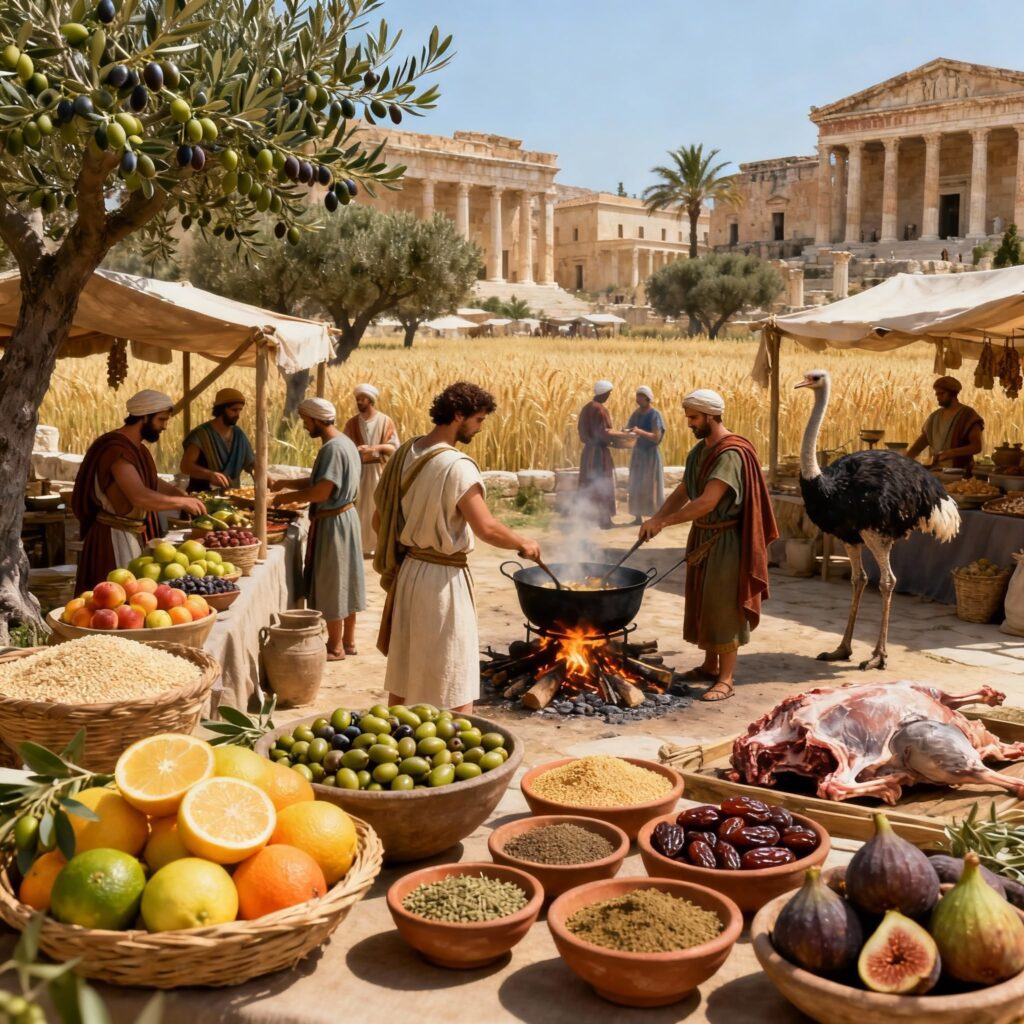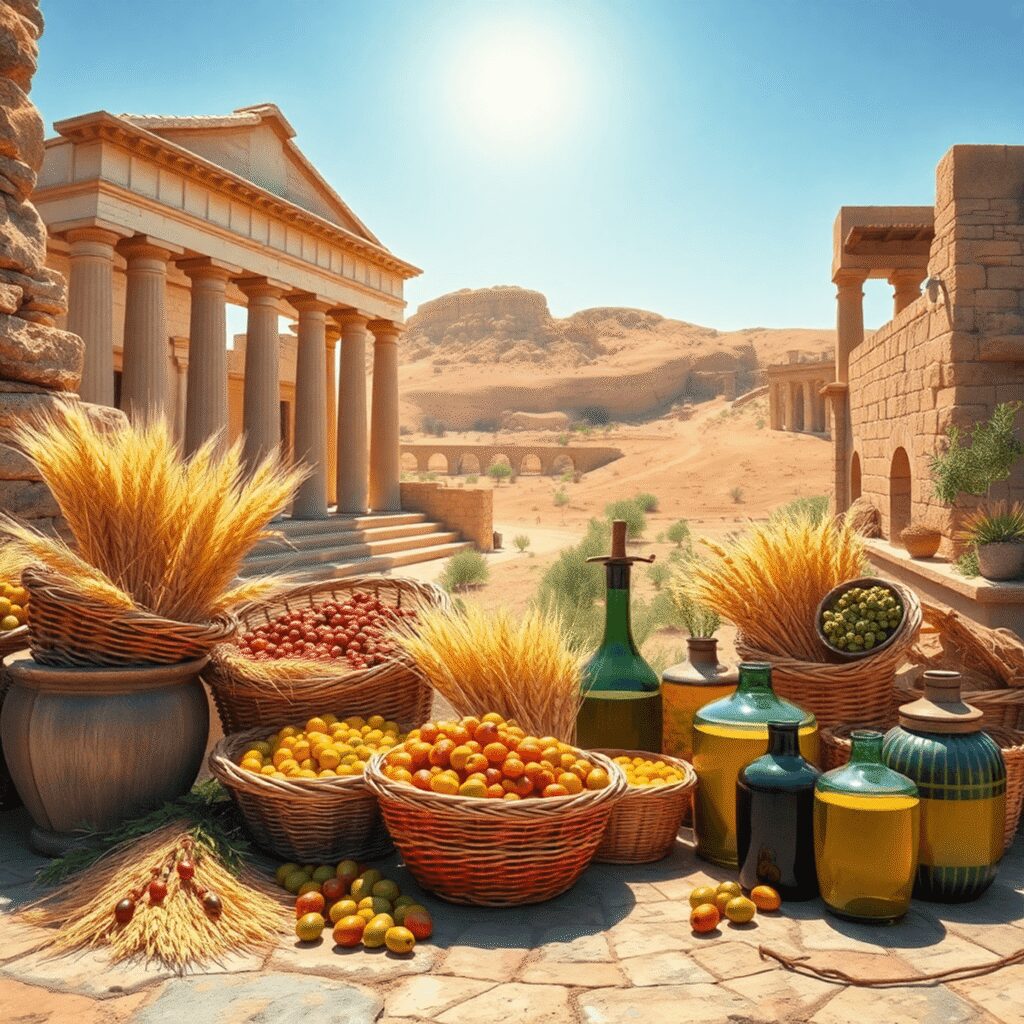The culinary influence of North Africa on Roman cuisine is an intriguing part of Mediterranean culinary history. The fertile lands and various cultures of North Africa significantly impacted Roman food culture, which still has an effect today.
Roman cuisine is a fundamental part of Western food traditions, known for its combination of simplicity and elegance. Its enduring impact can be seen in modern Mediterranean cooking methods that prioritize fresh ingredients, strong flavors, and creative use of spices.
In this article, we will explore how North African farming practices, migration patterns, and cultural interactions enriched Roman gastronomy. We will examine the links between ancient food customs and current trends, demonstrating how age-old influences continue to shape the meals enjoyed around the globe.
Historical Context: North Africa as Rome’s Breadbasket
North Africa played a crucial role in sustaining the Roman Empire agriculture system. The region’s fertile lands, especially in areas corresponding to modern Tunisia, Algeria, and Libya, produced vast quantities of grain and other crops essential to feeding Rome’s burgeoning population. This agricultural abundance earned North Africa the reputation of being the “breadbasket” of Rome.
Key Features that Made North Africa Vital for the Roman Food Supply
- Extensive cultivation of wheat and barley, staples for Roman diets.
- Olive groves producing oil used widely in cooking and lighting.
- Export of surplus grains via well-developed trade routes to Rome and other empire cities.
The city of Leptis Magna, located in modern-day Libya, stood as a prominent center of commerce and agriculture within this framework. It was also the birthplace of Emperor Septimius Severus, a figure symbolizing the integration of North African culture into the highest levels of Roman political life. His reign (193–211 AD) reflected both military strength and cultural fusion, highlighting how North African influence extended beyond agriculture into governance and society.
Septimius Severus’ legacy reminds us that North Africa was not only a source of food but also contributed leaders who shaped Roman history. The agricultural bounty from this region supported Rome’s expansion and urban growth, embedding North African products deeply into Roman culinary practices that would evolve over centuries.
However, it’s important to note that this period of prosperity was not to last. The very foundation of the empire began to crumble due to political instability and weak leadership, which served as a stark reminder of how internal strife can undermine even the most powerful civilizations.
Despite these challenges, the trade routes established during this time facilitated a thriving economy that influenced both daily life and long-term stability in Ancient Rome. The masterpieces of Roman art from this era further reflect the empire’s vast reach and its ability to assimilate and innovate (as detailed in this article about Masterpieces of Roman Art).
Cultural Diversity and Culinary Exchange in Ancient Rome
Ancient Rome was a melting pot of cultures, with North African immigrants playing a crucial role in shaping its culinary landscape. The Carthaginian influence brought rich agricultural knowledge and unique food practices, enriching Roman tables beyond simple staples. Immigrants from Berber and Jewish communities introduced distinct flavors and cooking methods that blended seamlessly with existing Roman traditions.
Greek Culinary Traditions
Greek culinary traditions had already established a foundation in Rome, emphasizing olive oil, wine, and fresh vegetables. The arrival of Libyan and Berber peoples added new dimensions to this foundation, including the use of diverse grains and pulses. Jewish communities contributed kosher dietary laws and specialty dishes that influenced Roman cuisine’s diversity.
Spices and Ingredients
Roman spices became more complex due to interactions with North African territories. Ingredients like cumin, coriander, asafoetida, and silphium (a now-extinct herb highly prized by Romans) were integrated into recipes. These spices enhanced everyday meals and ceremonial banquets alike.
New ingredients from conquered lands such as dates, figs, olives, and various herbs arrived in Rome’s markets regularly. This constant flow of goods allowed Roman chefs to experiment with flavors, combining traditional Mediterranean tastes with exotic elements.
Legacy of Roman Society
The influence of Roman society extended beyond just culinary practices; it laid the groundwork for many aspects of modern life. From their legal systems to their architectural marvels, the legacy of Rome is woven into the very fabric of contemporary society, showcasing the profound impact that Roman society has had on Western civilization.
- Carthaginian agricultural techniques improved grain production.
- Berber knowledge introduced wild herbs and game meats.
- Jewish culinary customs enriched festival foods.
- Greek influence ensured balance between flavor and nutrition.
- Roman spice blends expanded with North African imports.
This cultural fusion created a dynamic culinary environment that reflected Rome’s vast empire while honoring regional identities. Moreover, the evolution of art during this period, particularly Roman sculpture, mirrors these societal changes. These sculptures served not only as artistic expressions but also as instruments for political propaganda and religious devotion.
Additionally, the religious aspect of Roman life is highlighted through their pantheon of gods, which includes figures associated with power, justice, and wisdom. This diverse collection reflects the values and beliefs that influenced the lives of its people during ancient times.

Key Ingredients from North Africa in Roman Cuisine
North Africa’s fertile lands contributed significantly to the staple ingredients that shaped Roman culinary practices. The region’s agricultural abundance supplied Rome with key Mediterranean diet components, many of which became central to Roman tables.
Staple Ingredients from North Africa
- Olives and olive oil: Essential for cooking and flavoring, olives from North African groves provided a cornerstone of Roman diets. Olive oil was used not only in food but also in rituals and medicine.
- Grains: Wheat and barley cultivated extensively in North Africa earned the region its reputation as Rome’s “breadbasket.” These grains formed the basis of bread, porridge, and other staples.
- Fish sauces: Garum, a fermented fish sauce highly prized by Romans, often incorporated catches from North African coasts. This condiment added umami depth to many dishes.
Exotic Meats and Culinary Diversity
Roman chefs experimented boldly with exotic meats, including ostrich imported from North African deserts. This cuisine diversity reflected curiosity and access to new food sources beyond typical livestock.
Herbs and Spices from Trade Routes
Herbs and spices introduced or popularized through North African trade routes enriched Roman recipes:
- Cumin
- Coriander
- Mint
- Dill
- Silphium (a now-extinct herb once harvested in North Africa)
These aromatic elements elevated simple dishes into complex flavor profiles, demonstrating how Unraveling the Culinary Influence of North Africa on Roman Cuisine Trends Today reveals roots deep in this ancient exchange.
The influence of North African ingredients on Roman cuisine is just one aspect of a larger narrative that includes political and military strategies. For instance, coins were used as propaganda during this period, showcasing the power dynamics at play. Additionally, the Roman military’s strategy played a crucial role in expanding their territory into North Africa, further enriching their culinary landscape.
The Arab-Muslim Influence on Medieval Italian Cuisine via Sicily
The Arab occupation of Sicily from the 9th to the 11th century brought significant changes to the island’s food culture, leaving a lasting impact on Italian cuisine. This period became a crucial channel for introducing North African and Middle Eastern agricultural products and cooking techniques into Italy.
Key Ingredients Introduced by Arab Influence
Several key ingredients made their way into Italian kitchens through this Arab influence, many with origins tied directly to North Africa:
- Spinach and artichokes, both now staples in Italian cooking, were introduced during this era.
- Nuts such as almonds and pistachios enhanced desserts and savory dishes alike.
- Staple grains like durum wheat, essential for pasta production, took root under Arab cultivation practices.
- Rice, which later became important in northern Italian dishes like risotto, was also introduced.
- Citrus fruits such as lemons and oranges began to flourish in Mediterranean orchards thanks to Arab agricultural knowledge.
- Legumes including chickpeas enriched protein sources available to Italians.
- Exotic vegetables like aubergines (eggplants) expanded the variety of produce.
- Sweeteners like sugarcane reached Sicily, paving the way for new confectionery traditions.
Innovations in Pasta Production
The Arabs innovated dried pasta production techniques that formed the basis for Italy’s iconic pasta culture. This development connected back to North African trade routes and culinary practices. Such introductions not only diversified Italian ingredients but also transformed cooking methods, blending seamlessly with existing Roman and Mediterranean traditions.
This fusion laid groundwork for a rich culinary heritage that continues to influence modern Italian gastronomy.

Evolution of Italian Cuisine Reflecting North African-Roman Heritage Today
Modern Italian cuisine carries the rich legacy of the Mediterranean diet today, deeply rooted in Roman culinary traditions influenced by North Africa. The emphasis on fresh, high-quality ingredients remains central to Italian cooking, reflecting a historical preference established millennia ago.
Key Elements of Italian Cuisine
1. Pasta Evolution
Pasta stands as a symbol of Italy’s culinary roots, evolving through Etruscan and Greek influences before gaining refinement under Arab contributions during the medieval period. The use of durum wheat—introduced via North African channels—enabled durable dried pasta varieties essential to Italy’s food culture.
2. Simple Preparations with Bold Flavors
Italian dishes often highlight seafood, seasonal fruits, and vegetables prepared simply to preserve natural flavors. This approach echoes ancient Roman techniques that valued freshness and harmony between ingredients rather than heavy seasoning.
3. Sicilian Cheeses
Sicily’s cheeses reveal distinct Arab-North African heritage. Varieties like ricotta and pecorino incorporate methods and flavor profiles connected to North African dairy traditions. These cheeses complement regional dishes shaped by centuries of cultural blending, such as those found in this guide to Sicilian cuisine.
The persistence of these culinary traits showcases how ancient North African influences continue to enrich Italy’s gastronomic identity through Mediterranean flavors preserved from Roman times to today.
Lasting Legacy: How Ancient Culinary Exchanges Shape Modern Trends Worldwide
Centuries of cross-cultural culinary exchange between North Africa and Rome have left an indelible mark on global food culture. The Mediterranean flavors that originated from this blend now resonate widely, creating a shared heritage celebrated beyond regional borders. This historical ingredient continuity reveals itself in contemporary kitchens where ancient staples remain central.
Key elements persist in modern cooking trends:
- Spices and herbs like cumin, coriander, and saffron trace back to North African influence, enriching dishes with complex aromas.
- Ingredients such as olives, citrus fruits, chickpeas, and durum wheat continue to define Mediterranean diets across Europe, the Americas, and beyond.
- The adoption of diverse meats and plant-based foods reflects ancient experimentation that encouraged culinary innovation through cultural blending.
Chefs and food enthusiasts value this legacy for its ability to inspire new recipes while honoring tradition. By embracing ingredients introduced or popularized through Roman-North African interactions, modern cuisine showcases a dynamic fusion that transcends time.
The story of Mediterranean flavors worldwide is a testament to how Unraveling the Culinary Influence of North Africa on Roman Cuisine Trends Today helps us appreciate a vibrant tapestry of taste forged through millennia of cultural dialogue. This culinary journey also mirrors the broader influences of ancient Rome, including its enduring impact on modern legal systems, showcasing the multifaceted legacy of this ancient civilization. Moreover, these ancient culinary practices have not only shaped our palates but also influenced modern dietary patterns, highlighting the profound and lasting impact of these historical exchanges.
Conclusion
Preserving culinary heritage means more than just replicating recipes; it involves understanding the rich tapestry of historical food influence that shapes today’s Mediterranean gastronomy. The journey of flavors from North Africa to Roman tables and into modern kitchens reveals a fascinating story of cultural exchange, innovation, and adaptation.
“Unraveling the Culinary Influence of North Africa on Roman Cuisine Trends Today” invites you to appreciate how ancient connections continue to inspire contemporary tastes.
Consider these points as you explore further:
- Ancient food legacies provide insights into how societies adapted ingredients and techniques.
- The fusion of diverse culinary traditions sparks creativity in modern cooking.
- Recognizing historical roots enriches your appreciation for Mediterranean flavors.
Embracing this knowledge encourages deeper engagement with food culture and supports efforts in culinary heritage preservation. Let the past guide your palate toward discovering authentic, time-tested tastes that endure across centuries.
FAQs (Frequently Asked Questions)
How did North Africa influence Roman cuisine and its lasting legacy?
North Africa played a pivotal role in shaping Roman cuisine by supplying abundant agricultural produce, introducing diverse spices, herbs, and exotic ingredients like ostrich meat. This influence enriched Rome’s food culture and contributed to Mediterranean culinary history, leaving a lasting legacy evident in modern culinary trends.
Why was North Africa known as the ‘breadbasket’ of the Roman Empire?
North Africa was called the ‘breadbasket’ of Rome due to its prolific grain production that fed the vast Roman Empire. Regions like Leptis Magna were crucial agricultural hubs, supporting Rome’s food supply and highlighting the area’s importance in sustaining Roman society and economy.
What cultural influences from North Africa blended into ancient Roman cuisine?
Ancient Roman cuisine was enriched by cultural diversity brought by immigrants from North Africa, including Carthaginian, Berber, and Jewish communities. Combined with Greek culinary traditions, these influences introduced new spices, ingredients, and cooking techniques that diversified Roman food culture.
Which key ingredients from North Africa were incorporated into Roman culinary practices?
Key North African ingredients incorporated into Roman cuisine included olives, grains, fish sauces, roasted game such as ostrich meat, along with a variety of herbs and spices. These staples contributed to the Mediterranean diet components adopted by Romans and showcased culinary experimentation.
How did Arab-Muslim rule in Sicily impact Italian cuisine through North African connections?
During the Arab-Muslim occupation of Sicily in the Middle Ages, numerous spices and fruits originating from North Africa were introduced to Italy. Ingredients like spinach, almonds, rice, citrus fruits, artichokes, chickpeas, pistachios, sugarcane, aubergines, and durum wheat enriched Italian food culture and influenced developments such as dried pasta.
In what ways does modern Italian cuisine reflect its North African-Roman heritage?
Modern Italian cuisine preserves Mediterranean flavors rooted in Roman times with clear North African influences. Emphasizing quality ingredients like pasta—shaped by Etruscan-Greek-Arab traditions—seafood, fruits, vegetables, and Sicilian cheeses demonstrates this heritage. These elements highlight the enduring impact of historical culinary exchanges on Italy’s gastronomic identity.

